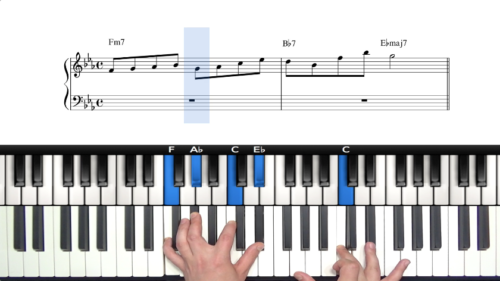Stride Rootless Voicings
In this lesson we explore rootless voicing options which incorporate the chord extensions and alterations that we covered in the 2nd module of this course.
In this lesson you will learn:
-
The process for turning rooted extended voicings into rootless voicings with stride left hand.
-
The most important rootless voicing inversions which are ‘Type A’ and ‘Type B’. These inversions ensure smooth voice leading in 25s and 251s and help us to play the rootless voicings in the optimal range of the piano.
-
Step-by-step drills to gain fluency and control with left hand stride and extended rootless voicings. This approach can be applied to any jazz standard or tune that you are working on.
‘Type A’ & ‘Type B’ Rootless Voicings
These two voicing configurations are the most important and useful. With these two configurations, we can always ensure that smooth voice-leading is created for 25s and 251s and that the rootless voicings are played in the optimal range of the piano.
Major & Minor Chord Rootless Formulas
For major and minor chords, the ‘Type A’ rootless voicing configuration is chord tones 3-5-7-9, and the ‘Type B’ configuration is 7-9-3-5. By inverting the ‘Type A’ voicing twice, we achieve the ‘Type B’ voicing and so these voicings contain the same notes but simply ‘voiced’ in a different order.
Dominant Chord Rootless Formulas
For dominant 7 chords, the ‘Type A’ voicing configuration is 3-13-b7-9, and the ‘Type B’ is b7-9-3-13. In the context of 25 progressions, only 1 note changes from the ii-7 chord to the V7 chord which is the 7th dropping to the 3rd. All other notes stay the same.
Lesson Downloads
-
Extended Rootless Voicings File Type: pdf
Practice Tips
-
We don't always have to play bass note --> chord --> bass note --> chord etc... it can also be effective to omit occasional bass notes and just outline the rootless harmony.
-
Experiment with both Type A and Type B rootless voicing configurations and always focus on smooth voice leading and clean fingering.
-
Understand that "7" is a form of jazz shorthand. For example, on the basic lead sheet for 'Body & Soul' we will see the chords: Eb-7, Bb7, Eb-7, Ab7, Dbmaj7, Gb7, F-7, etc...
-
We always have the creative freedom to add chord extensions such as 9, 11, and 13, and also alterations such as b9, #9, #11, and #5/b13 to enhance the basic 7th chords.








The B flat dominant and C minor flat 5 rootless chords started on the 5 th note and not the 3d or 7th. Please explain these exceptions. I have seen this exception in one other book. Thanks,
Hi Edwin,
Great question here!
For the Bb7, notice that it’s b9 dominant chord (Bb7b9), and so if we omit the root we can treat this as a rootless diminished chord. The diminished chord I play is an Fdim7, which from bottom to top is F, Ab, Cb(or B) and D. Notice that we have the 3rd and 7th of Bb7 in there (Ab and D) and so it’s a rootless Bb7 with the 5th on the bass.
It’s also worth noting that Fdim7, is also Abdim7, Bdim7, and Ddim7 – simply by inverting the notes. Any of these inversions work and we can play any inversion as our left hand voicings, but always remember that rootless voicings sound best when they are close to middle C.
For the C-7b5, I am playing the 11th of the chord, which makes it a C-11b5, check out this lesson which explains those voicing configurations: pianogroove.com/jazz-piano-lessons/left-hand-minor-251s-advanced/
If we play the root in the lower registers in a stride style, we have the freedom to incorporate the tones such as the 11th for the C-7b5 chord. You will notice that sometimes I omit the minor 3rd from my left hand voicing, but the melody hits the minor 3rd so again we have some freedom to omit this from our left hand voicing.
Finally notice that I don’t play the roots for all chords which adds some interesting textural variety to my left hand accompaniment and breaks up the monotony of root…chord…root…chord…root…chord etc….
Let me know if I can help further here.
Talk soon,
Hayden